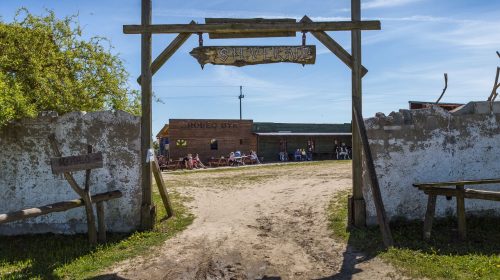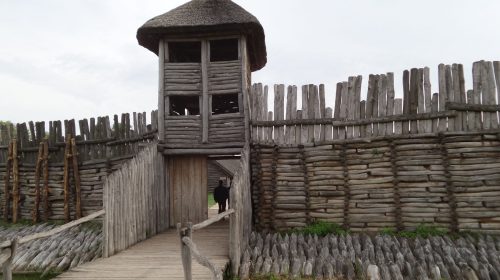“If I weren’t a filmmaker, I would have probably become a historian. I love history, first and foremost the history of Poland, which is certainly reflected in my film work inspired by literary works” – Jerzy Hoffman.*
In this film, Jerzy Hoffman, creator of the monumental screen adaptations of the Trilogy by Henryk Sienkiewicz, takes us on a film journey which takes place in the times of the first rulers of the Piast Dynasty.
Contrary to the rustic image of the Piast Dynasty – the first Dynasty of Polish sovereigns – created over the course of the ages, they had nothing to do with an assortment of peace-loving peasants. Peace-loving peasants, as people living in cottages, and farmers, used to be called at the time, would somewhat fear the rulers of the Piast Dynasty. Their favourite method of settling disputes was brute force or treason.
And this is exactly the story told in Stara baśń. Kiedy słońce było bogiem/An Ancient Tale: When the Sun Was a God, almost all of which was filmed in a region known as Pałuki, the capital of which is Żnin.
The action in the film takes places in the 9th Century, one hundred years before Poland became a Christian country. In a land situated by the Gopło Lake, with its capital in Kruszwica, the ruler is Popiel (Bohdan Stupka), the Bloody Prince, who, instigated by his wife (Małgorzata Foremniak), murders his entire family to ensure the succession for his son.
In addition to Olbrychski, Stupka, Foremniak, and Żebrowski, the landscape of Pałuki welcomed a number of other prominent cinema stars. The following actors gave excellent performances in supporting roles: Jerzy Trela as the Priest Wizun, Anna Dymna as the wife of Wisz, Ewa Wiśniewska as the Witch Jarucha, and Andrzej Pieczyński as the servant Znosek, as well as late Maciej Kozłowski as the commander of Popiel’s army.
Landscapes of Pałuki: Żnin, Biskupin, and the environs
From 29th August to 2nd September, and then from 10th September to 19th September, 2002, the film crew worked in the village of Drewno, located by the Oćwieckie Lake. That was the setting for filming the crossing of an army, the events taking place in Mirsza’s cottage during a celebration of Kupala Night, and scenes filmed inside the temple of Svetovid. Biskupin was portrayed beautifully in the scene taking place at the cottage of Wisza, the surroundings of which became the breathtaking green forest in the film. Jerzy Hoffman also filmed in Chomiąża Szlachecka.
Trivia
- Nearly all the elements in the film set in Stara Baśń are situated along the Piast Trail.
- The screenplay was not a faithful adaptation of the novel by Jóżef Ignacy Kraszewski. It was written by Jerzy Hoffman and Józef Hen, and features its own dramaturgy. The motifs taken directly from the novel by Kraszewski are interlaced with scenes based on tales, legends, and the imagination of the authors.
- Krzesimir Dębski composed the soundtrack without even seeing any shots from the film, which he received many months later. According to his own words, the film was “exactly what I had imagined it to be, both musically and visually”.
- When recording the music, the composer used ancient instruments, for example the Germanic lyre (hrotta), which documents prove to have existed as early as in the 10th Century.
- All the historic threads in both the novel and the film have their origins in Early Mediaeval chronicles: Thietmar’s Chronicle (the end of the 10th Century and the beginning of the 11th Century), the Gesta principum Polonorum (The Deeds of the Princes of the Poles, 10th Century), and Chronica Polonorum, written by Wincenty Kadłubek (the end of the 12th Century and the beginning of the 13th Century).
- Tytus Byczkowski, a graphic artist specialising in caricature, reporter, and columnist, has written a book based on his experiences on the film set for Stara baśń. The book is entitled Stara baśń. Kiedy słońce było Bogiem. Od kuchni (An Ancient Tale: When the Sun Was a God from the Inside).
- Some of the shoots were also done in Rogalin (the region of Wielkopolska) and near Ostrów.
- The film’s budget was PLN 11 mln.
Information on the film
Stara baśń. Kiedy słońce było bogiem / An old fairy tale. When the Sun was a God
Poland 2003, 107′
Directed by: Jerzy Hoffman
Screenplay: Józef Hen, Jerzy Hoffman
Cinematography: Paweł Lebieszew, Jerzy Gościk
Music: Krzesimir Dębski
Produced by: Jerzy Michaluk
Cast: Bohdan Stupka, Michał Żebrowski, Daniel Olbrychski, Małgorzata Foremniak, Daniel Olbrychski, and others.
Selected Awards
Polish Film Awards: Eagles – the awards for best costumes, nomination for best music, best production design, best editing; Gdynia Film Festival – nomination for Golden Lions – participation in the Main Completion, Golden Duck Awards – An award for the best music in a Polish film, and nomination for acting for Małgorzata Foremniak.
* The quote comes from a film press conference which took place in the Relax cinema in Warsaw in 2003.


